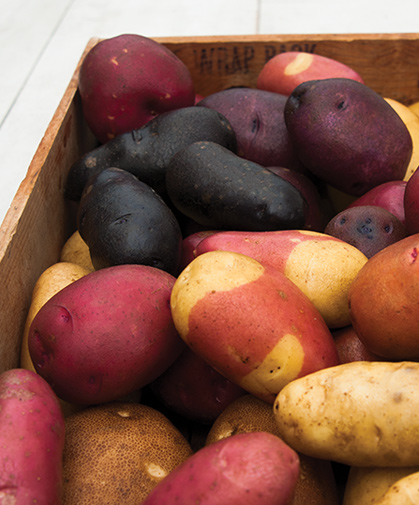- Potato Varieties | Comparison Chart (PDF)
- 'Red Gold' Potatoes | Information on Early Breaking of Dormancy | Tech Sheet (PDF)
- Classic Storage Crops | Post-Harvest Handling & Storage Guidelines
- Potatoes | Key Growing Information
- Certified Seed Potatoes | Growing Instructions | Tech Sheet (PDF)
- Greensprouting Potatoes | Breaking Dormancy Prior to Planting
Potatoes - Key Growing Information

CULTURE: Potatoes grow best in well-drained, fertile soil with a pH of 6.0-7.0. Cut tubers into pieces roughly 1 1/2-2 oz. (1-1 1/4" diameter) each, with at least one "eye" per piece. Small tubers may be planted whole. Potatoes can be planted in early to midspring as they tolerate cool soil and moderate frost. Plant seed pieces 2-3" deep, 12" apart, in rows 30-36" apart. Plants will emerge 2-3 weeks later. When the plants are 6-8" tall, hill them by mounding soil from each side of the row about 4" high along the base of the plants to protect developing tubers from greening. Repeat hilling process as plants grow until hills are about 12" high.
DISEASES: The best disease control is fertile soil, crop rotation, and consistent moisture.
INSECT PESTS: Row covers work well to exclude insect pests such as Colorado potato beetles, aphids, and leafhoppers. Otherwise, scout for yellow-orange potato beetle eggs on undersides of leaves and crush them; manually remove and dispose of larvae and adults. Potato beetles can also be controlled with a spinosad insecticide.
HARVEST: Small, "new" potatoes can be harvested beginning about 7-8 weeks after planting. After foliage has died back, leave main crop tubers in the ground for 2 weeks to set skin. Dig tubers, brush off soil, and allow skins to dry before storing. Store in a cool but not freezing 40°F (4.4°C) dark, humid place.
AVG. PLANTING RATE: 10 lb./80-100' at 12" spacing; 110 lb./1,000'; 1,600 lb./acre in rows 36" apart.
SEED SPECS: Avg. 8-10 pieces/lb.; fingerling type: avg. 20 pieces/lb.

